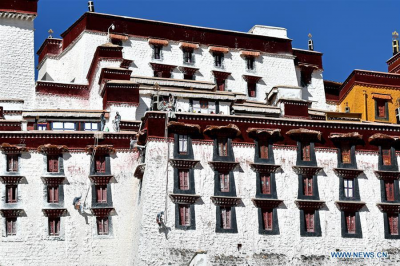 Sept.24, 2019 -- Photo shows that an artisan is busy with engraving work. [Hunan Daily/Tong Di] Sept.24, 2019 -- Nyemo County, renowned for "the birthplace of Tibetan incense", boasts lush vegetation and pleasant climate. Pusum Town in Nyemo County is famous for engraving, which is one of the "three treasures of Nyemo" (Tibetan incense, paper and engraving). Pusum Town is located in Nyemo County of Lhasa, capital of southwest China's Tibet Autonomous Region. In recent years, with the implementation of rural revitalization strategy, Pusum has adopted the mode of "intangible heritage culture + poverty alleviation" to broaden local income channels.
Pusum Town is known as "the hometown of engraving". Half of local households are engaged in engraving and prayer flag printing. With a long history, Pusum engraving, an ancient craft, has been passed down from generation to generation. It is inherited and developed by artisans. Now, the content of engraving covers etiquette, natural scenery and modern social life. As the tour market is increasingly prosperous, the engraving works are gradually developed into the art and tourism products, of which the woodcarving is popular with tourists. In 2009, Pusum engraving craft was inscribed on the list of autonomous-region-level intangible cultural heritage.
The Pusum engraving is crafted and exquisite. With a total of more than 30 procedures, the engraving making process includes picking wood and carving, which is regarded as an ancient handcraft that cannot be replaced by modern machines.
52-year-old Siqu has started to learn the engraving craft since he was 14 years old. Siqu and his younger brother Tenzin Namgyal are the seventh-generation inheritors of their family's engraving craft. Their skills are the best in the whole village. They have also trained dozens of apprentices. As a representative inheritor of autonomous-region-level intangible cultural heritage, experienced Siqu considers that he has the responsibility to carry forward this ancient craft. In 2016, Siqu set up a handcraft cooperative of farmers and herdsmen, encouraging 16 people in Nyemo County to study the engraving craft. Now, some apprentices can earn 150,000 yuan RMB annually.
Generally speaking, it takes at least five to six years to master the engraving craft. The procedure of engraving is complicated, and the carving knife used is particular. The engraving artisan usually uses his own carving knife. It takes almost half a month to complete an engraving work that costs over 1,500 yuan RMB.
There are nearly 20 engraving handcraft cooperatives in Pusum Town. Through the integration, the engraving industry has realized scale development.
A collectively-owned farmers and herdsmen's cooperative -- Xiaokang Cooperative was established in Chushur Village in June of 2018. In this way, the ancient crafts are well developed and inherited. The Pusum engraving industry helps more impoverished people to get rid of poverty, and brings them wealth. Now, the cooperative employs four managers, ten engraving experts and 36 workers. Among them, there are 14 people from registered impoverished households. In 2018, the cooperative realized a total of 28 million yuan RMB in revenue, effectively increasing the local income.
41-year-old Nyandrak living in Chushur Village started to learn engraving craft when he was 14 years old. He began to work in engraving field 20 years ago. During that time, he could earn 200 yuan RMB every day in Lhasa, capital of southwest China's Tibet Autonomous Region. "After joining the cooperative, I didn't need to leave home for work. I could earn 250 to 300 yuan RMB every day in my hometown. It is more than I earned before," says Nyandrak.
In Pusum's Ruba Village, Karma Chodrak, a representative inheritor of Lhasa municipal-level intangible cultural heritage, is good at Tibetan calligraphy engraving. His business in engraving goes well. However, he doesn't forget to help the local villagers to get rich. Thanks to the support from Nyemo county government, Karma Chodrak set up a Tibetan calligraphy engraving cooperative in April, 2016. He takes the lead in bringing the local wealth by providing jobs and distributing dividends. Among his 40 apprentices, some have become rich through their skills.
"In the future, I plan to develop the economic value of engraving products and combine the tourism culture with engraving crafts. With new elements, the engraving work will become easy to carry. I want to explore the market and introduce Nyemo engraving products to other places outside Tibet," says Karma Chodrak.
"The output value of engraving industry contributed 12.6% of the whole township's income in 2016. The output value reached 5.18 million yuan in 2018, accounting for 21.8% of the township's income," says Tenzin, Party secretary of Pusum Town, "We have confidence in broadening the channels for increasing the local income through the development of this distinctive industry, while not forgetting to protect and inherit the ancient crafts."
In order to inherit and develop Pusum engraving, Nyemo County has adopted various measures to support the engraving industry and explore ways to add values on engraving products, which will help spread Tibetan traditional culture further.
|
- Home
- News Tibet |Exclusive |China |World |Other Tibetan-Inhabited Area |Tibet through the Eyes of Foreigners |Related News
- Documents White Papers |Others
- Photo Politics |Economy & Society |Culture & Religion |Human & Nature |Beautiful Tibet |Other Tibetan-Inhabited Area |Exchanges |Related
- Video News |Documentary |Micro-Video |Entertainment
- Art
- Tourism
- In Focus
- About Tibet






